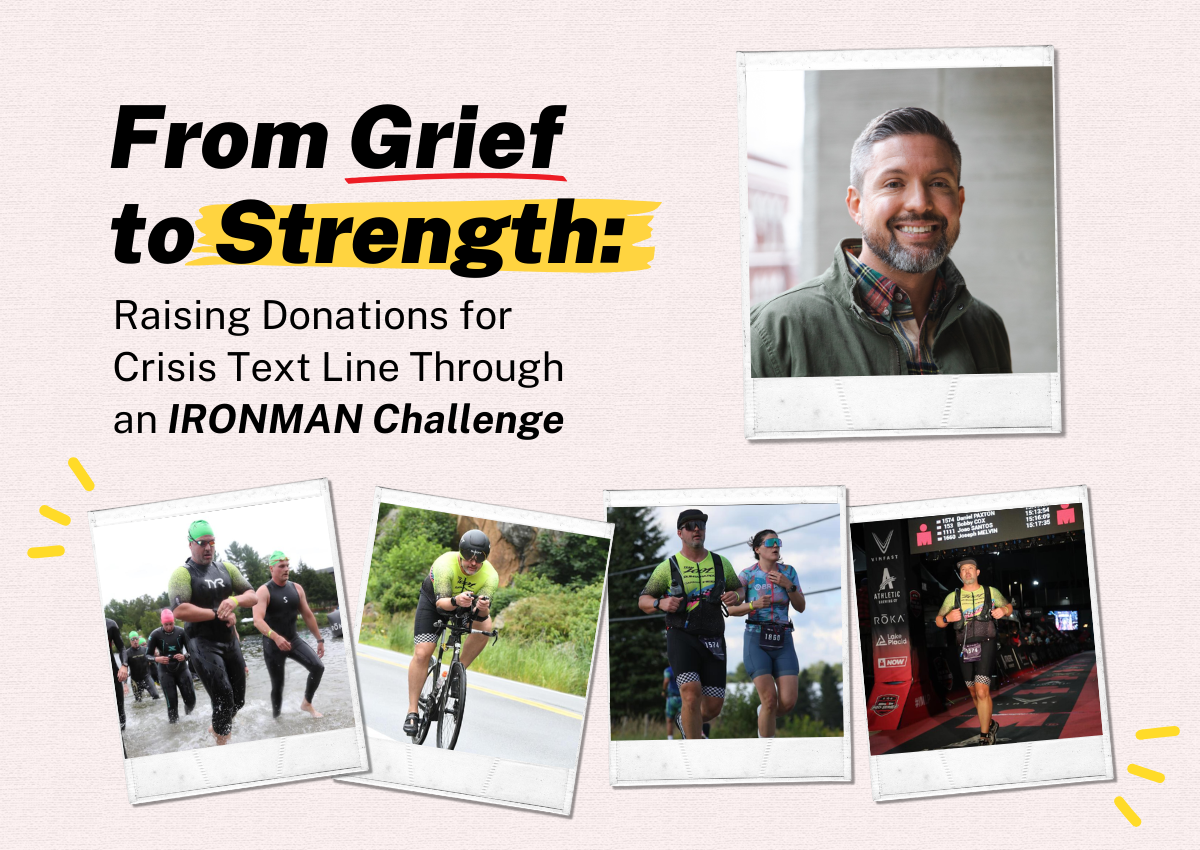From Grief to Strength: Raising Donations for Crisis Text Line Through an IRONMAN Challenge

After losing his brother Michael to suicide in 2017, former Crisis Text Line volunteer Daniel Paxton turned personal grief into a mission for change. Combining his passion for mental health advocacy with the intense challenge of an IRONMAN triathlon, he raised donations to advance accessible mental health support and suicide prevention. By fundraising for Crisis Text Line, Daniel is furthering our mission of providing free, 24/7 mental health support and crisis intervention via text message.
In this interview, he shares how the memory of his brother, community support, and his own perseverance carried him through 140.6 miles of swimming, biking, and running.
What inspired you to raise donations for suicide prevention and Crisis Text Line?
In January of 2017, at the age of 37, my brother Michael chose to end his life, leaving behind a wife, four children, and many other family members. Losing my brother to mental health has been very tough to accept over the past 7 years, and I wanted to ensure that services like Crisis Text Line are always available to anyone that needs it at any time. I myself was a volunteer for Crisis Text Line in 2022 and felt the impact of being available for those in need. The conversations I had often hit really close to home for me. I wanted to make sure that volunteers had the training and resources they needed to continue providing such an important and necessary service to our communities.
Many people wonder how they can start a fundraiser for a nonprofit. How did your fundraising effort come together?
I organized this fundraiser with the help of the IRONMAN Foundation. In 2022, I joined the amazing triathlon community, drawn to the sport for its challenges and dedication. Through the foundation, IRONMAN collects donations and processes them for a nonprofit chosen by the athlete—common in many races but sometimes requires research to find.
After registering, selecting Crisis Text Line as my nonprofit, and completing the forms, the IRONMAN Foundation took care of the rest, providing me with a shareable link. The community showed up in force, with friends and family contributing generously to support me, Crisis Text Line, and those who rely on it. I shared our family’s story about the choice that Mike made that day back in 2017 and the community showed up to help support me, Crisis Text Line, and essentially all those individuals that utilize this service. I could not begin to express how grateful I am for the community around me.
What is an Ironman race and what goes into training for a triathlon?
Some may say that an IRONMAN race is pure lunacy, but I saw it as a mountain to climb and a challenge worth fighting for.
It’s not just a single day of going out and swimming, biking, and running, but months of training and support from so many individuals around me. We spent countless hours training over several months and commiserating about our shared experiences as we all prepared for various races throughout the season.
In total, I logged 2,375.78 miles preparing for and completing this race. I swam 88.94 miles, ran 505.56 miles, and biked 1,781.28 miles. By no means is a triathlon an individual sport, it truly takes a community to get all of us to the finish line. I had several friends with me for so many of those miles cheering me along the way from the sidelines and from across the country. I know I would not have been able to get there without every one of them.
Can you tell us more about your race day experience? How many miles is an Ironman, and what does the triathlon consist of?
A full IRONMAN consists of 140.6 miles, which is broken down by a 2.4 mi. swim, 112 mi. bike, and a 26.2 mi. run, and must be completed within 17 hours. There are various checkpoints that each athlete must pass to continue with their race and oftentimes even hitting those can be a challenge.
For me, let’s just say that it was a very long day, but I had so many reasons to keep on pushing through until I finally crossed that finish line. There were moments when I wanted to just call it a day, but I knew that I couldn’t give up. When there were moments of doubt, I would reach out to and chat with those around me and we would talk about our “why”. Everyone has a reason, and everyone has a story, all you have to do is ask and be open to listening and truly hearing what they have to tell you. You take in so much from your community and when you take a moment and realize this, you will find that you are never, ever, alone.
Looking back, what are you most grateful for after racing to support Crisis Text Line and mental health awareness?
I’m grateful for every moment that led up to that finish line. This cause gave me so much more motivation to keep on pushing through to the end.
Most importantly, I’m extremely grateful to my community of friends and family members who supported me in this cause and generously donated to such an important organization that offers an amazing service to those in need 24/7/365.
–
Daniel’s journey shows how resilience and community can turn tragedy into something truly meaningful. You can make a difference too in your own way this Giving Season by donating to Crisis Text Line or becoming a volunteer and supporting those who need it most!
Other blogs you might like:
4 Ways to Support Suicide Prevention for Giving Tuesday
How to help a friend who is suicidal or struggling emotionally

